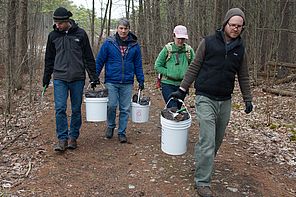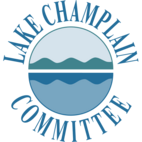April Stools' Day
April 2015

There is no poop fairy. That’s the ingenious marketing message used around the Denver, CO area to nudge irresponsible pet owners to begin taking care of their dogs’ waste. Their public service announcement notes, “"Like the Loch Ness Monster or Bigfoot, the fabled poop fairy has been the stuff of legend. Flying undetected in parks, neighborhoods and schoolyards, she was said to follow close behind dogs and their owners -- picking up what the dog left behind, before flying off to the next canine creation. A widespread belief that she existed seemed to reassure some that cleaning up after one's dog was sort of ... optional." This time of year as snow slowly recede dog waste takes center stage among the unwelcome surprises revealed beneath the melting banks, and it is worthwhile to remember here, there is no poop fairy.
Estimates of pet ownership in the United States suggest that between 36 and 47% of all households own dogs. Vermont has the highest rate of pet ownership in the union at 70.8% (which does not distinguish between different types of pets) with New York coming in with the third lowest rate at 50.6%. The difference is probably due to New York’s much more urban population as pet ownership is lower in cities.
Many dog owners are responsible and clean-up their pets’ messes, but winter can be a time when the occasionally conscientious lose their discipline. Excuses abound: it’s cold; nobody is watching; it’s too dark to find the pile; it's too hard to open the bag with gloves on. The problem is that the waste from just a few irresponsible owners’ hounds built up over the entire winter creates a depressingly large pile.
The statistics website fivethirtyeight.com estimated dogs generate 96 tons of waste in New York City each day! That is one pound for every 350 feet of sidewalk.
Besides the foul smell and the unpleasantness of stepping in hound mounds, pet poop is bad for waterways, lawns and people. Pet waste carries nutrients that feed the growth of weeds and algae in the water. EPA estimates that two or three days' worth of droppings from just 100 dogs contributes enough bacteria to temporarily close a waterbody to swimming and fishing. Dog waste contains 23-million fecal coliform bacteria per gram. Sampling in four mid-western cities found ten to fifty percent of bacteria in air samples was derived from feces with dog poop being a particularly dominant source.
Woof-waste doesn't make good fertilizer; it burns grass and leaves unsightly discoloring. Infected pet poop can carry the eggs of roundworms and other parasites (like cryptosporidium, giardia, and salmonella) which can linger in soil for years. Anyone gardening, playing sports, walking barefoot, or digging in the infected dirt, risks coming into contact with those eggs. Children are most susceptible since they often play in the dirt and put things in their mouths.
The poop fairy is not the only creative means to encourage pet waste pick-up. One Spanish town mails neglected mounds to the dog’s owner in government-branded boxes labelled “Lost Property”. Volunteers who observe negligent owners engage in conversation with the owner and ask their dogs’ name and breed. The city can then cross reference the information with registered pets in the town to get addresses. In Mexico City dog owners get free Wi-Fi minutes when they deposit poop in specially marked boxes at certain city parks. Heavier bags earn more minutes.
Yet all those strategies don't address the problem of pet poop left behind by irresponsible owners. To combat the apathy, the Lake Champlain Committee (LCC) hosted our second annual “April Stools' Days” at various locations throughout the Champlain Basin. On Saturday, April 25 organizers and volunteers gathered at parks and trails throughout the watershed to help "scoop the poop" that's accumulated over the winter. Events occurred in Bristol, Burlington, St. Albans, and Williston.
If you were unable to attend one of the park clean-ups you can still help keep our recreation areas clean. Whenever you have time, head out to your favorite park, trail or neighborhood with gloves, plastic bags and a sturdy trowel and help scoop the poop. Wear a safety vest if working near roadways. Pet poop should be flushed down the toilet or deposited in the garbage along with any other trash you find during your outings.
Lake Look is a monthly natural history column produced by the Lake Champlain Committee (LCC). Formed in 1963, LCC is the only bi-state organization solely dedicated to protecting Lake Champlain’s health and accessibility. LCC uses science-based advocacy, education, and collaborative action to protect and restore water quality, safeguard natural habitats, foster stewardship, and ensure recreational access.
Get involved by joining LCC using our website secure form (at www.lakechamplaincommittee.org), or mail your contribution (Lake Champlain Committee, 208 Flynn Avenue - BLDG 3 - STUDIO 3-F, Burlington, VT 05401), or contact us at (802) 658-1414, or lcc@lakechamplaincommittee.org for more information.
